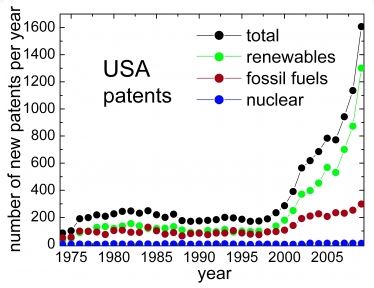The world of patents is a bit screwy these days, with trolls warping a system that was designed to encourage innovation by protecting and rewarding innovators. Still, it has to be seen as an encouraging sign for renewable energy that the number of patents issued in the broad field has skyrocketed of late.
Researchers from the Massachusetts Institute of Technology and the Santa Fe Institute said that annual renewable-energy patents in the United States increased fivefold from the quarter-century preceding 2000 to the decade that followed, from fewer than 200 per year to more than 1,000 annually by 2009. Fossil-fuel-related patents were also up, but just threefold, from 100 per year pre-2000 to 300 per year in 2009.
Perhaps the most hopeful news in the study was the suggestions that increases in research funding can have a cumulative, long-lasting impact that can help keep innovation rolling along even through investment ups and downs.

For instance, a large increase in energy research following the oil shocks of the 1970s and 1980s was followed by a steep dropoff, the researchers said. But report co-author Jessika Trancik, an assistant professor of engineering systems at MIT, said the effect of those investments has helped drive this current patent boom. From the study:
We find that both market-driven investment and publicly-funded R&D act as base multipliers for each other in driving technological development at the global level. We also find that the effects of these investments persist over long periods of time, supporting the notion that technology-relevant knowledge is preserved.
The two most prominent forms of renewable energy (excluding hydropower) have not surprisingly been getting a lot of the innovation focus. “[B]etween 2004 and 2009, the number of patents issued annually for solar energy increased by 13 percent per year, while those for wind energy increased 19 percent per year, on average; these growth rates approach or exceed the rates for technologies such as semiconductors and digital communications,” MIT said.

But while growing markets can help bring about the investment necessary for innovations in these technologies, the researchers said markets alone won’t do the job.
To the extent that markets for these technologies grow fast enough, economic opportunity drives an increase in patenting and knowledge creation. It is important to emphasize that the growth of markets for low-carbon energy technologies, which improve on an aspect of performance (carbon emissions) not commonly captured by market price (and therefore not visible to the consumer), has depended strongly on public policy. We also note that policies are likely needed to fund research and incentivize market growth further until these technologies become cost-competitive and can take off on their own.
The paper, “Determinants of the Pace of Global Innovation in Energy Technologies,” was to published in the open-source, peer reviewed journal Plos One. A submitted version is available online as a PDF.